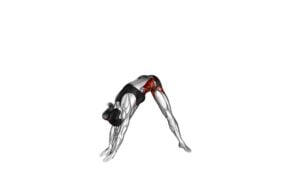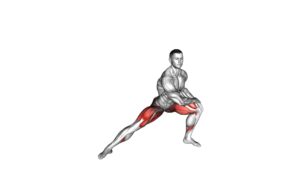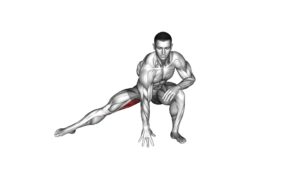Adductor Stretch (female) – Video Exercise Guide & Tips

Are you looking for a quick and effective way to stretch your adductor muscles? Look no further!
Watch This Exercise Video
In this video exercise guide, we'll show you the proper form and technique for the adductor stretch.
You'll also learn about the benefits, equipment needed, modifications, and common mistakes to avoid.
Whether you're a beginner or more advanced, incorporating the adductor stretch into your routine is a great way to improve flexibility and prevent injuries.
Let's get started!
Key Takeaways
- The adductor stretch improves flexibility in the inner thighs and increases range of motion in the hips and groin area.
- Proper form and technique for the adductor stretch include sitting on the floor with legs extended and back straight, spreading legs apart while keeping knees and toes pointing upward, engaging core muscles, and leaning forward from the hips.
- Alternative exercises for the adductor muscles include inner thigh lifts and side lunges, which provide variety and target the adductor muscles in different ways, enhancing overall muscle activation and coordination.
- The adductor stretch can be done at home or at the gym with no fancy equipment required, although a sturdy chair or flat surface to sit on, a yoga strap or resistance band for intensifying the stretch, and a stability ball for a seated position variation can be used.
Benefits of the Adductor Stretch
One major benefit of the adductor stretch is that it helps improve flexibility in your inner thighs. This stretch specifically targets the adductor muscles, which are responsible for moving your legs towards the midline of your body. By regularly performing the adductor stretch, you can increase the range of motion in your hips and groin area, allowing for a greater range of movement in activities such as squatting, lunging, and running.
When you perform the adductor stretch, you activate these muscles, which helps to strengthen and lengthen them over time. This can lead to improved muscle activation and coordination, reducing the risk of injury during physical activity. Additionally, increased adductor flexibility can enhance your overall athletic performance by improving your balance and stability.
Incorporating the adductor stretch into your exercise routine is simple and can be done anywhere. Start by sitting on the floor with your legs extended out in front of you. Then, slowly spread your legs apart as far as comfortable, keeping your knees straight. Lean forward from your hips and try to touch your chest to the ground. Hold this position for 20-30 seconds, breathing deeply and focusing on relaxing your muscles.
Proper Form and Technique
To ensure you're performing the adductor stretch correctly, how can you maintain proper form and technique?
Proper form and technique are crucial when performing the adductor stretch to maximize its benefits and reduce the risk of injury. First, start by sitting on the floor with your back straight and legs extended in front of you. Then, slowly spread your legs as far apart as comfortable while keeping your knees and toes pointing upward. Avoid rounding your back or leaning forward, as this can compromise the effectiveness of the stretch. Instead, focus on keeping your torso upright and engaging your core muscles. Gently lean forward from your hips, aiming to feel a stretch in your inner thighs. Hold this position for 15 to 30 seconds, breathing deeply and relaxing into the stretch. Remember to never bounce or force the stretch, as this can strain the muscles.
Common misconceptions about the adductor stretch include the belief that a deeper stretch is always better. It's important to listen to your body and not push beyond your comfort level. If you feel any sharp pain or discomfort, ease off the stretch immediately.
If you're looking for alternative exercises to target the adductor muscles, consider trying inner thigh lifts or side lunges. Inner thigh lifts involve lying on your side and lifting your top leg towards the ceiling, focusing on engaging the inner thigh muscles. Side lunges involve stepping out to the side and bending the knee while keeping the other leg straight, targeting the adductors along with the glutes and quadriceps. Incorporating these alternative exercises into your routine can provide variety and help strengthen and stretch the adductor muscles in different ways.
Equipment Needed for the Exercise
To perform the adductor stretch, you'll need minimal equipment. In fact, all you need is a sturdy chair or a flat surface to sit on. This exercise can be done at home or at the gym, making it accessible to anyone. No fancy equipment or expensive machines required.
There are also variations of the adductor stretch that you can try, which may require additional equipment. For instance, if you want to intensify the stretch, you can use a yoga strap or resistance band. Simply loop the strap or band around your feet and gently pull towards your body to increase the stretch on your adductor muscles.
Another variation involves using a stability ball. Sit on the ball with your legs wide apart and gently lean forward to stretch your adductors. This can be a great option for individuals who prefer a seated position rather than a standing or lying down position.
Modifications and Progressions
You can modify and progress the adductor stretch to further challenge your muscles and improve flexibility. Here are three ways you can modify and progress this exercise:
- Increase the range of motion: Start by sitting with your legs spread wide apart and gently lean forward to feel a stretch in your groin area. As you become more flexible, try increasing the distance between your legs and lean further forward to deepen the stretch.
- Use resistance bands: Loop a resistance band around your feet and hold onto the ends. This will provide added resistance as you move into the stretch. You can adjust the tension of the band to match your strength and comfort level.
- Incorporate dynamic movements: Instead of holding the stretch statically, try adding dynamic movements. For example, you can gently rock side to side or pulse in and out of the stretch. This will help improve your mobility and activate the muscles in your groin area.
Common Mistakes to Avoid
Avoidance of common mistakes is crucial in performing the adductor stretch effectively. To ensure proper alignment and muscle activation, there are a few common mistakes that you should avoid.
First, be mindful of your posture throughout the stretch. Keep your back straight and avoid leaning forward or rounding your shoulders. This will help target the adductor muscles more effectively.
Another mistake to avoid is overstretching. While it's important to feel a gentle stretch, pushing too hard can lead to injury. Instead, focus on gradually increasing the intensity of the stretch over time.
Lastly, make sure to breathe deeply and relax your muscles during the stretch. Tension and holding your breath can hinder the effectiveness of the stretch.
By avoiding these common mistakes, you can optimize the benefits of the adductor stretch and prevent any potential injuries.
Now that you know what to avoid, let's move on to some tips for incorporating the adductor stretch into your routine.
Tips for Incorporating the Adductor Stretch Into Your Routine
To effectively incorporate the adductor stretch into your routine, consider these helpful tips:
- Gradually increase intensity: Start with a gentle adductor stretch and gradually increase the intensity as your flexibility improves. Push yourself to a comfortable limit, but avoid overstretching or causing pain.
- Include variations: There are several variations of the adductor stretch that can target different muscles and increase flexibility in various ways. Experiment with different positions, such as a seated or standing adductor stretch, to find what works best for you.
- Consistency is key: To see progress in your flexibility, it's important to incorporate the adductor stretch into your routine consistently. Aim for at least three times a week, and gradually increase the duration of each stretch session.
Frequently Asked Questions
How Long Should I Hold the Adductor Stretch for Maximum Benefit?
To get the most benefit from the adductor stretch, it's important to hold the stretch for an adequate duration. The duration of the stretch will vary depending on your flexibility and comfort level.
Generally, holding the adductor stretch for 20-30 seconds is recommended. However, you can also try variations of the stretch, like pulsing or deepening the stretch, to further enhance its effectiveness.
Remember to listen to your body and never push yourself past your limits.
Can the Adductor Stretch Help With Reducing Hip Pain?
Yes, the adductor stretch can help reduce hip pain.
By stretching the muscles on the inner thigh, the adductor stretch can improve flexibility and range of motion in the hip joint.
This can help alleviate any tightness or discomfort you may be experiencing.
To maximize the benefits of the adductor stretch, make sure to maintain proper technique and hold the stretch for an appropriate amount of time.
Is It Safe to Perform the Adductor Stretch if I Have a Previous Groin Injury?
Yes, it's important to exercise caution and modify the adductor stretch if you have a previous groin injury. Consult with a healthcare professional or physical therapist for guidance on adductor stretch modifications that can accommodate your injury.
They can also assist you in creating a safe and effective adductor stretch progression plan. Prioritizing your safety and seeking expert advice will help prevent further injury and promote healing.
Can the Adductor Stretch Be Beneficial for Athletes in Sports Such as Soccer or Basketball?
The adductor stretch can be highly beneficial for athletes in sports like soccer or basketball. It helps to improve flexibility and range of motion in the groin and inner thigh muscles, which are essential for movements like kicking, cutting, and lateral movements.
Are There Any Alternative Exercises or Stretches That Can Target the Adductor Muscles?
Looking for alternative exercises or effective stretches to target your adductor muscles? There are several options you can try.
One alternative exercise to consider is the side lunge, which engages the adductor muscles while also working other lower body muscles.
Another effective stretch is the butterfly stretch, where you sit with the soles of your feet together and gently push your knees towards the ground.
These exercises and stretches can help improve flexibility and strength in your adductor muscles.
Conclusion
In conclusion, the adductor stretch is a beneficial exercise for females that can help improve flexibility and prevent injuries.
By using proper form and technique, and gradually progressing the intensity of the stretch, you can effectively target the adductor muscles.
Remember to avoid common mistakes and incorporate this stretch into your routine for optimal results.
Keep stretching and stay flexible!

Author
Years ago, the spark of my life’s passion ignited in my mind the moment I stepped into the local gym for the first time. The inaugural bead of perspiration, the initial endeavor, the very first surge of endorphins, and a sense of pride that washed over me post-workout marked the beginning of my deep-seated interest in strength sports, fitness, and sports nutrition. This very curiosity blossomed rapidly into a profound fascination, propelling me to earn a Master’s degree in Physical Education from the Academy of Physical Education in Krakow, followed by a Sports Manager diploma from the Jagiellonian University. My journey of growth led me to gain more specialized qualifications, such as being a certified personal trainer with a focus on sports dietetics, a lifeguard, and an instructor for wellness and corrective gymnastics. Theoretical knowledge paired seamlessly with practical experience, reinforcing my belief that the transformation of individuals under my guidance was also a reflection of my personal growth. This belief holds true even today. Each day, I strive to push the boundaries and explore new realms. These realms gently elevate me to greater heights. The unique combination of passion for my field and the continuous quest for growth fuels my drive to break new ground.



